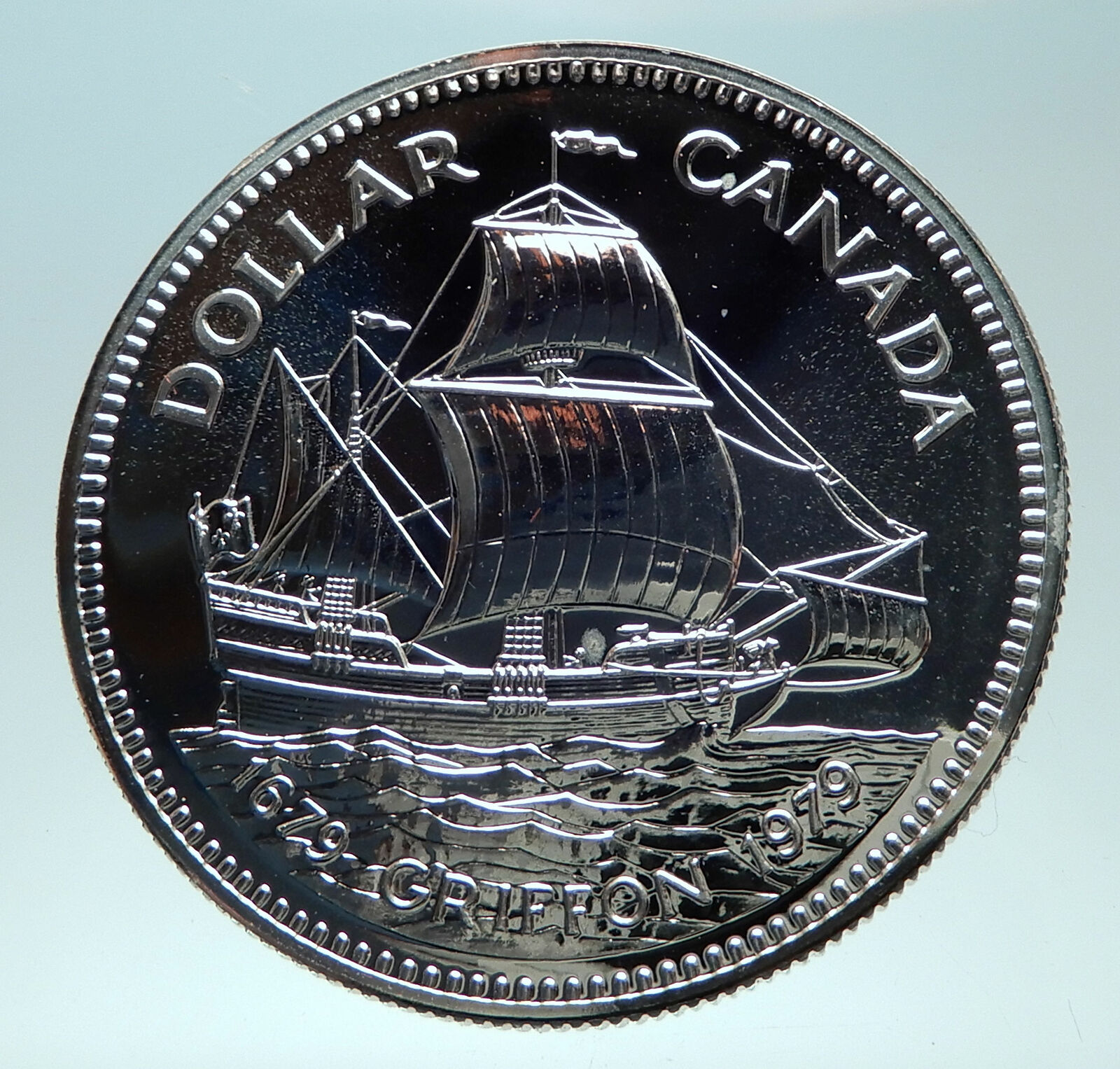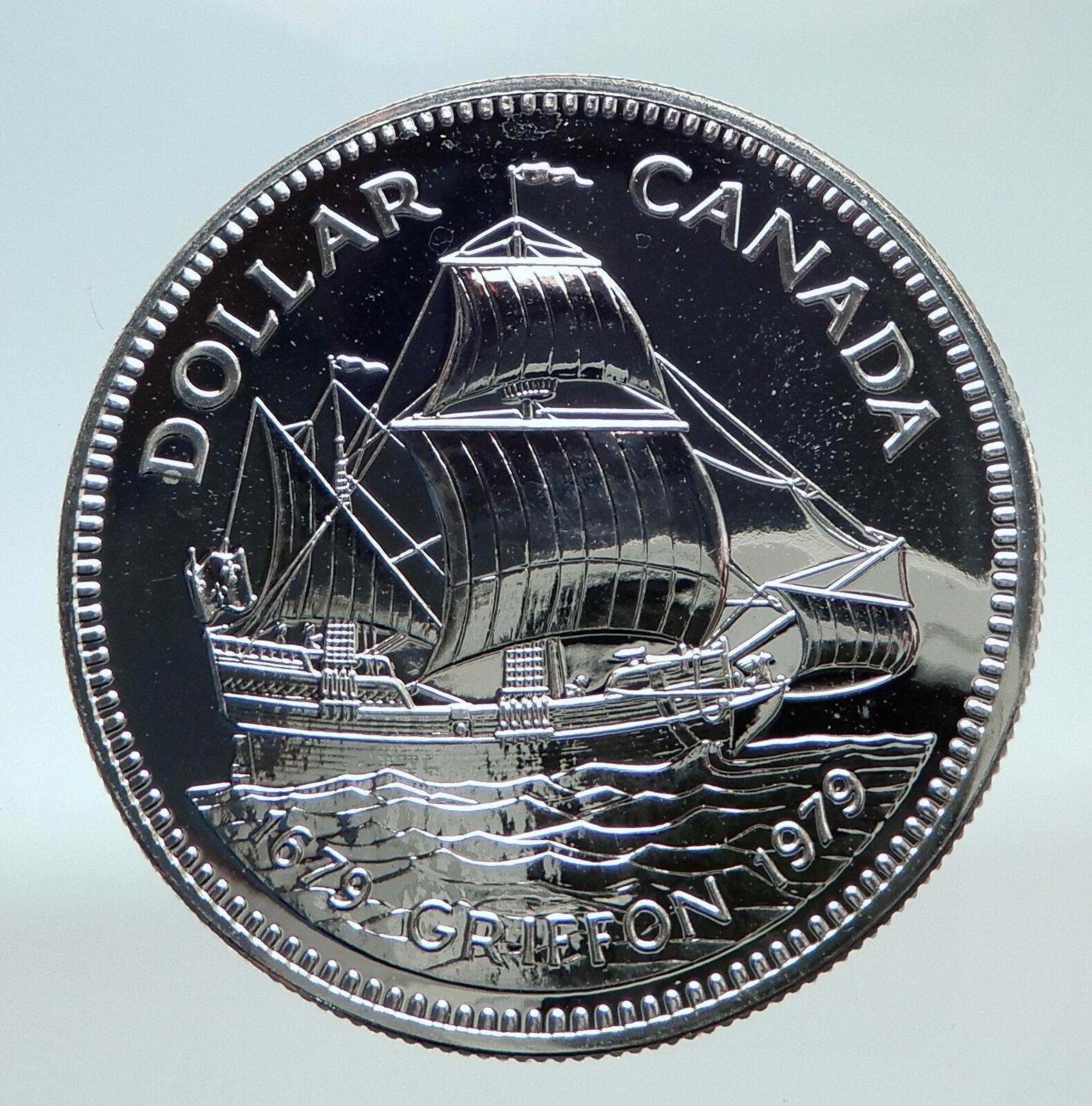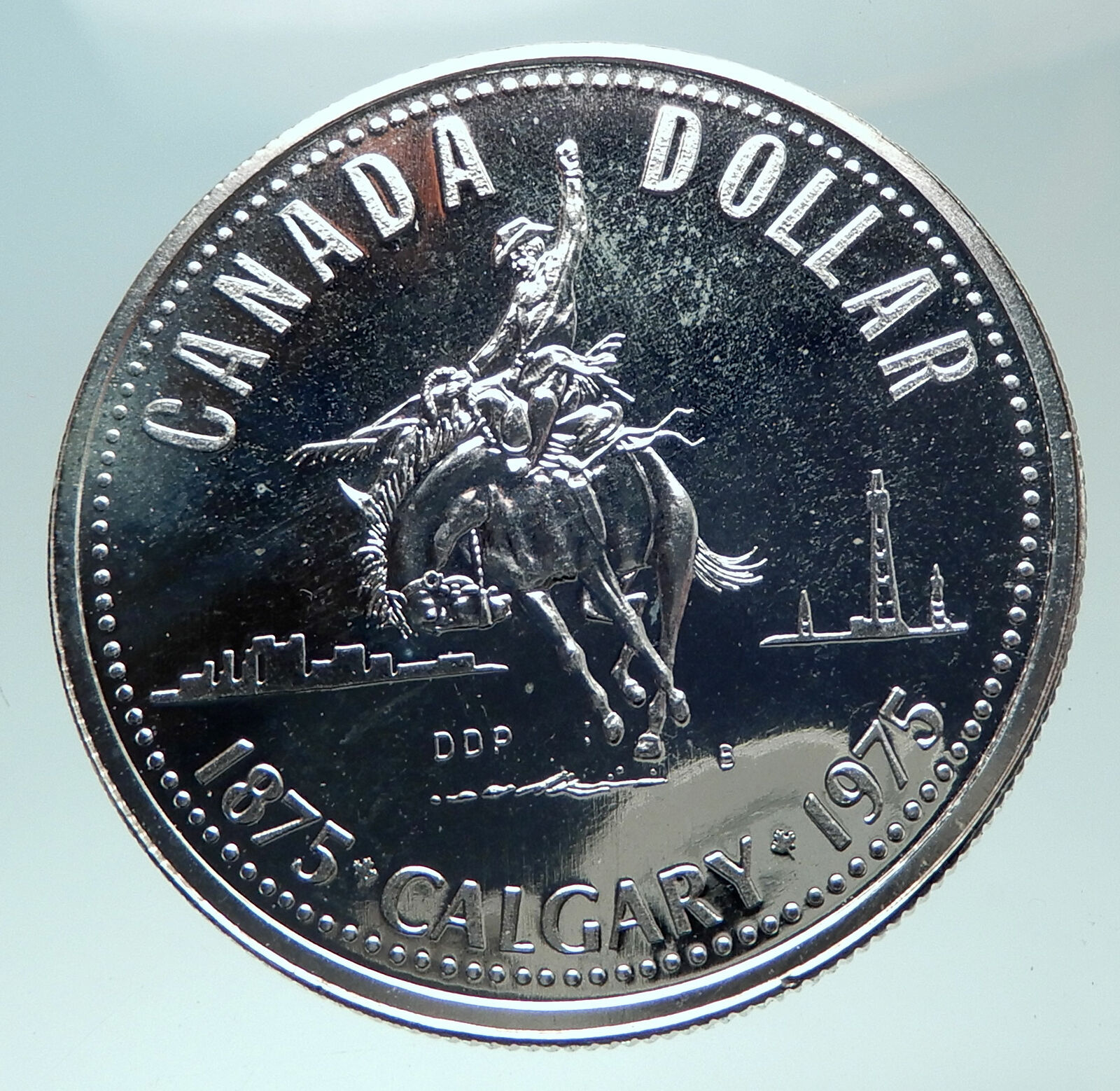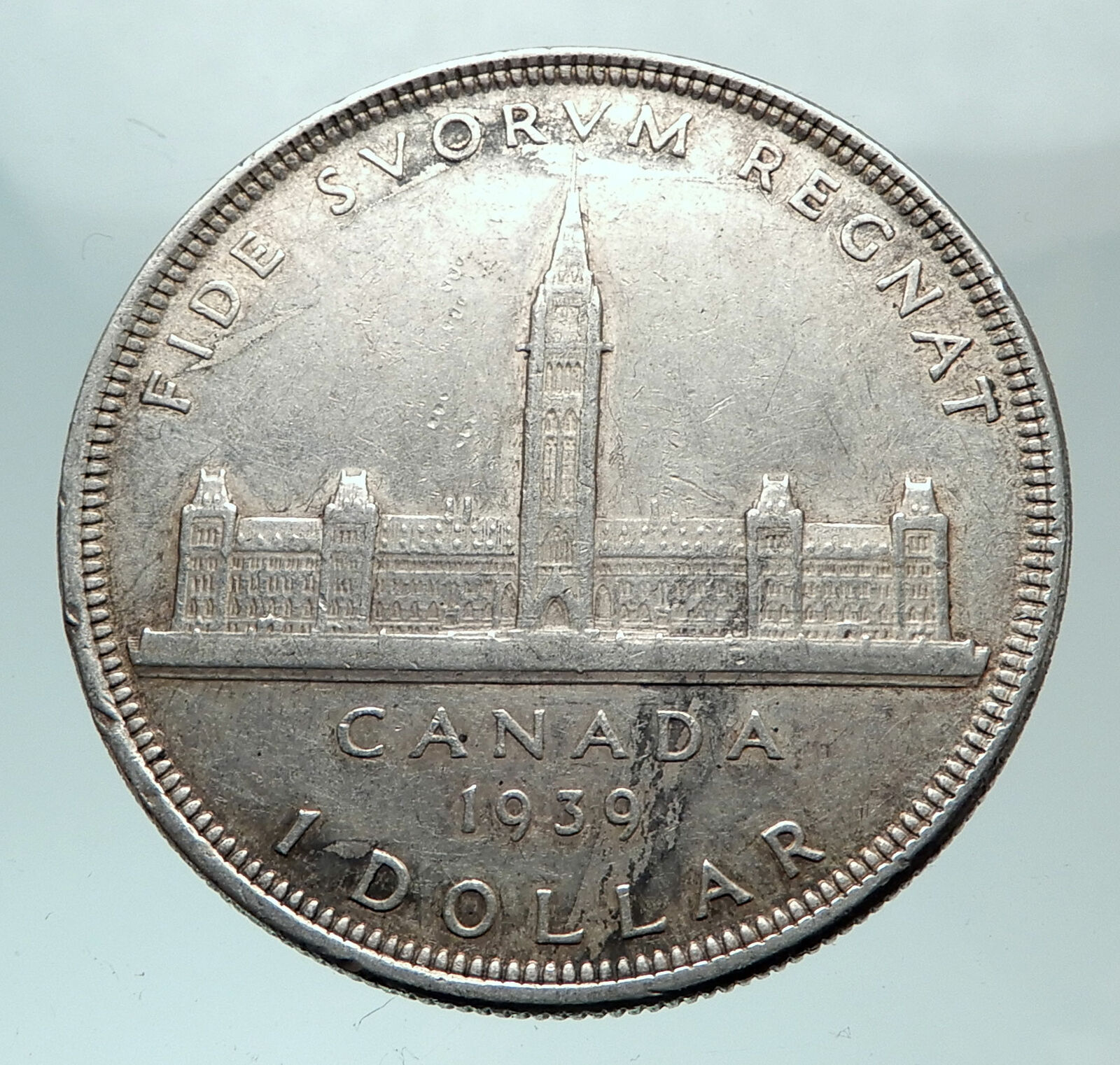|
Canada under Elizabeth II – Queen: 6 February 1952–present
Proof Set of 7 Coins
The Silver coin is:
1991 Proof Silver Dollar 36mm (23.00 grams) 0.500 Silver (0.375 oz. ASW)
Reference: KM# 179
ELIZABETH II D.G. REGINA, Queen Elizabeth II facing right.
1816 FRONTENAC CANADA 1991 DOLLAR, Ship steaming on water, fishermen waving from island shore.
Coin Notes:
The 1991 Proof Dollar marks the 175th anniversary of the launching of the Steamer Frontenac, on the Bay of Quinte, Lake Ontario, in 1816.
This commemorative issue celebrates the first steamship to sail on the Great Lakes. Built by a partnership of Kingston merchants in 1815, the Frontenac established a regular passenger and freight route between Prescott and Burlington by 1817, thus becoming the first Canadian built steamship to operate on Lake Ontario.
Design :
The coin design, by Ontario artist David Craig, depicts the Frontenac sailing on Lake Ontario. She holds the distinction of being the first Canadian built, paddle-driven steamship on any of the Great Lakes.
You are bidding on the exact item pictured, provided with a Certificate of Authenticity and Lifetime Guarantee of Authenticity.
Frontenac was a steamboat, the first paddle steamer launched on the Canadian side of the Great Lakes, in 1816.
Built in Ernesttown, Ontario, by American contractors for Kingston businessmen during 1816 at a cost of £15,000, she entered service in spring 1817. Frontenac conducted regular runs across Lake Ontario between Kingston, York (now Toronto), and Niagara-on-the-Lake. The round trip fare between Kingston and York was $18 ($12 one way) in cabin class.
Frontenac typically generated about 50 horsepower (using the original Boulton and Watt formula), which was too little for a ship of her size, and she was often outperformed by sailing craft. She rarely managed to make money in eight years; the provincial population was simply too small.
Frontenac was sold for £1550 to John Hamilton in 1824, who persisted two more unsuccessful years before selling her for scrap at Niagara in 1827. Before she could be scrapped, she burned to the waterline due to arson. Parts of her engines were salvaged and used later in the Alciope on Lake Ontario and Adelaide on Lake Erie.
.svg/220px-Canada_(orthographic_projection).svg.png) Canada is a country, consisting of ten provinces and t Canada is a country, consisting of ten provinces and t hree territories, in the northern part of the continent of North America. It extends from the Atlantic to the Pacific and northward into the Arctic Ocean, covering 9.98 million square kilometres (3.85 million square miles) in total, making it the world’s second-largest country by total area and the fourth-largest country by land area. Canada’s common border with the United States forms the world’s longest land border. Canada is sparsely populated overall, the majority of its land territory being dominated by forest and tundra as well as the mountain range of the Rocky Mountains; about four-fifths of the population live near to the southern border. The majority of Canada has a cold or severely cold winter climate, but southerly areas are warm in summer. hree territories, in the northern part of the continent of North America. It extends from the Atlantic to the Pacific and northward into the Arctic Ocean, covering 9.98 million square kilometres (3.85 million square miles) in total, making it the world’s second-largest country by total area and the fourth-largest country by land area. Canada’s common border with the United States forms the world’s longest land border. Canada is sparsely populated overall, the majority of its land territory being dominated by forest and tundra as well as the mountain range of the Rocky Mountains; about four-fifths of the population live near to the southern border. The majority of Canada has a cold or severely cold winter climate, but southerly areas are warm in summer.
The land now called Canada has been inhabited for millennia by various Aboriginal peoples. Beginning in the late 15th century, British and French colonies were established on the region’s Atlantic coast. As a consequence of various conflicts, the United Kingdom gained and lost North American territories until left, in the late 18th century, with what mostly comprises Canada today. Pursuant to the British North America Act, on July 1, 1867, three colonies joined to form the autonomous federal Dominion of Canada. This began an accretion of provinces and territories to the new self-governing Dominion. In 1931, Britain granted Canada near total independence with the Statute of Westminster 1931 and full sovereignty was attained when the Canada Act 1982 severed the vestiges of legal dependence on the British parliament.
Canada is a federal parliamentary democracy and a constitutional monarchy, Queen Elizabeth II being the current head of state. The country is officially bilingual at the federal level. It is one of the world’s most ethnically diverse and multicultural nations, the product of large-scale immigration from many countries, with a population of approximately 35 million as of 2015. Its advanced economy is the eleventh largest in the world, relying chiefly upon its abundant natural resources and well-developed international trade networks. Canada’s long and complex relationship with the United States has had a significant impact on its economy and culture.
Canada is a developed country and one of the wealthiest in the world, with the tenth highest nominal per capita income globally, and the eighth highest ranking in the Human Development Index. It ranks among the highest in international measurements of government transparency, civil liberties, quality of life, economic freedom, and education. Canada is a Commonwealth Realm member of the Commonwealth of Nations, a member of the Francophonie, and part of several major international and intergovernmental institutions or groupings including the North Atlantic Treaty Organization, the G8, the Group of Ten, the G20, the North American Free Trade Agreement and the Asia-Pacific Economic Cooperation forum.
|





.svg/220px-Canada_(orthographic_projection).svg.png) Canada is a country, consisting of ten provinces and t
Canada is a country, consisting of ten provinces and t hree territories, in the northern part of the continent of North America. It extends from the Atlantic to the Pacific and northward into the Arctic Ocean, covering 9.98 million square kilometres (3.85 million square miles) in total, making it the world’s second-largest country by total area and the fourth-largest country by land area. Canada’s common border with the United States forms the world’s longest land border. Canada is sparsely populated overall, the majority of its land territory being dominated by forest and tundra as well as the mountain range of the Rocky Mountains; about four-fifths of the population live near to the southern border. The majority of Canada has a cold or severely cold winter climate, but southerly areas are warm in summer.
hree territories, in the northern part of the continent of North America. It extends from the Atlantic to the Pacific and northward into the Arctic Ocean, covering 9.98 million square kilometres (3.85 million square miles) in total, making it the world’s second-largest country by total area and the fourth-largest country by land area. Canada’s common border with the United States forms the world’s longest land border. Canada is sparsely populated overall, the majority of its land territory being dominated by forest and tundra as well as the mountain range of the Rocky Mountains; about four-fifths of the population live near to the southern border. The majority of Canada has a cold or severely cold winter climate, but southerly areas are warm in summer.




